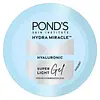What's inside
What's inside
 Key Ingredients
Key Ingredients

 Benefits
Benefits

 Concerns
Concerns

 Ingredients Side-by-side
Ingredients Side-by-side

Water
Skin ConditioningDimethicone
EmollientGlycerin
HumectantButylene Glycol
HumectantAmmonium Acryloyldimethyltaurate/Vp Copolymer
Niacinamide
SmoothingLinoleamidopropyl Pg-Dimonium Chloride Phosphate
Phenoxyethanol
PreservativeAmmonium Acryloyldimethyltaurate/Beheneth-25 Methacrylate Crosspolymer
Emulsion StabilisingParfum
MaskingSodium PCA
HumectantDisodium EDTA
Stearic Acid
CleansingCaprylic/Capric Triglyceride
MaskingTocopheryl Acetate
AntioxidantTriethanolamine
BufferingBHT
AntioxidantIodopropynyl Butylcarbamate
PreservativePEG-9 Diglycidyl Ether/Sodium Hyaluronate Crosspolymer
Skin ConditioningCitral
PerfumingCitronellol
PerfumingGeraniol
PerfumingHexyl Cinnamal
PerfumingLimonene
PerfumingLinalool
PerfumingCI 42090
Cosmetic ColorantWater, Dimethicone, Glycerin, Butylene Glycol, Ammonium Acryloyldimethyltaurate/Vp Copolymer, Niacinamide, Linoleamidopropyl Pg-Dimonium Chloride Phosphate, Phenoxyethanol, Ammonium Acryloyldimethyltaurate/Beheneth-25 Methacrylate Crosspolymer, Parfum, Sodium PCA, Disodium EDTA, Stearic Acid, Caprylic/Capric Triglyceride, Tocopheryl Acetate, Triethanolamine, BHT, Iodopropynyl Butylcarbamate, PEG-9 Diglycidyl Ether/Sodium Hyaluronate Crosspolymer, Citral, Citronellol, Geraniol, Hexyl Cinnamal, Limonene, Linalool, CI 42090
Propylene Glycol
HumectantUrea
BufferingLecithin
EmollientMagnesium Aluminum Silicate
AbsorbentCarbomer
Emulsion StabilisingGlycerin
HumectantSodium Hydroxide
BufferingCaprylic/Capric Triglyceride
MaskingDimethicone
EmollientSqualene
EmollientPEG-40 Stearate
EmulsifyingStearic Acid
CleansingGlycol Stearate
EmollientGlyceryl Stearate
EmollientCetyl Alcohol
EmollientMyristyl Myristate
EmollientOleth-10 Carboxylic Acid
CleansingBHA
AntioxidantToluene
AntioxidantWater
Skin ConditioningEDTA
Propylene Glycol, Urea, Lecithin, Magnesium Aluminum Silicate, Carbomer, Glycerin, Sodium Hydroxide, Caprylic/Capric Triglyceride, Dimethicone, Squalene, PEG-40 Stearate, Stearic Acid, Glycol Stearate, Glyceryl Stearate, Cetyl Alcohol, Myristyl Myristate, Oleth-10 Carboxylic Acid, BHA, Toluene, Water, EDTA
 Reviews
Reviews

Ingredients Explained
These ingredients are found in both products.
Ingredients higher up in an ingredient list are typically present in a larger amount.
This ingredient is an emollient, solvent, and texture enhancer. It is considered a skin-softener by helping the skin prevent moisture loss.
It helps thicken a product's formula and makes it easier to spread by dissolving clumping compounds.
Caprylic Triglyceride is made by combining glycerin with coconut oil, forming a clear liquid.
While there is an assumption Caprylic Triglyceride can clog pores due to it being derived from coconut oil, there is no research supporting this.
Learn more about Caprylic/Capric TriglycerideDimethicone is a type of synthetic silicone created from natural materials such as quartz.
What it does:
Dimethicone comes in different viscosities:
Depending on the viscosity, dimethicone has different properties.
Ingredients lists don't always show which type is used, so we recommend reaching out to the brand if you have questions about the viscosity.
This ingredient is unlikely to cause irritation because it does not get absorbed into skin. However, people with silicone allergies should be careful about using this ingredient.
Note: Dimethicone may contribute to pilling. This is because it is not oil or water soluble, so pilling may occur when layered with products. When mixed with heavy oils in a formula, the outcome is also quite greasy.
Learn more about DimethiconeGlycerin is already naturally found in your skin. It helps moisturize and protect your skin.
A study from 2016 found glycerin to be more effective as a humectant than AHAs and hyaluronic acid.
As a humectant, it helps the skin stay hydrated by pulling moisture to your skin. The low molecular weight of glycerin allows it to pull moisture into the deeper layers of your skin.
Hydrated skin improves your skin barrier; Your skin barrier helps protect against irritants and bacteria.
Glycerin has also been found to have antimicrobial and antiviral properties. Due to these properties, glycerin is often used in wound and burn treatments.
In cosmetics, glycerin is usually derived from plants such as soybean or palm. However, it can also be sourced from animals, such as tallow or animal fat.
This ingredient is organic, colorless, odorless, and non-toxic.
Glycerin is the name for this ingredient in American English. British English uses Glycerol/Glycerine.
Learn more about GlycerinStearic Acid is a fatty acid. It is an emollient, emulsifier, and texture enhancer.
As an emollient, stearic acid helps soften skin. It aids the skin's protective barrier by preventing water loss. It also provides a gentle cleansing effect without stripping away natural oils.
Stearic acid may also be used to enhance the texture of products. It can add volume and stabilize ingredients such as water and oil. This can help water and oil ingredients from separating.
Sources of stearic acid include animal or vegetable fats/oils such as coconut or shea. It can be naturally found in butter, cocoa butter, shea butter, vegetable fats, and animal tallow.
This ingredient may not be Malassezia folliculitis, or fungal-acne safe.
Learn more about Stearic AcidWater. It's the most common cosmetic ingredient of all. You'll usually see it at the top of ingredient lists, meaning that it makes up the largest part of the product.
So why is it so popular? Water most often acts as a solvent - this means that it helps dissolve other ingredients into the formulation.
You'll also recognize water as that liquid we all need to stay alive. If you see this, drink a glass of water. Stay hydrated!
Learn more about Water